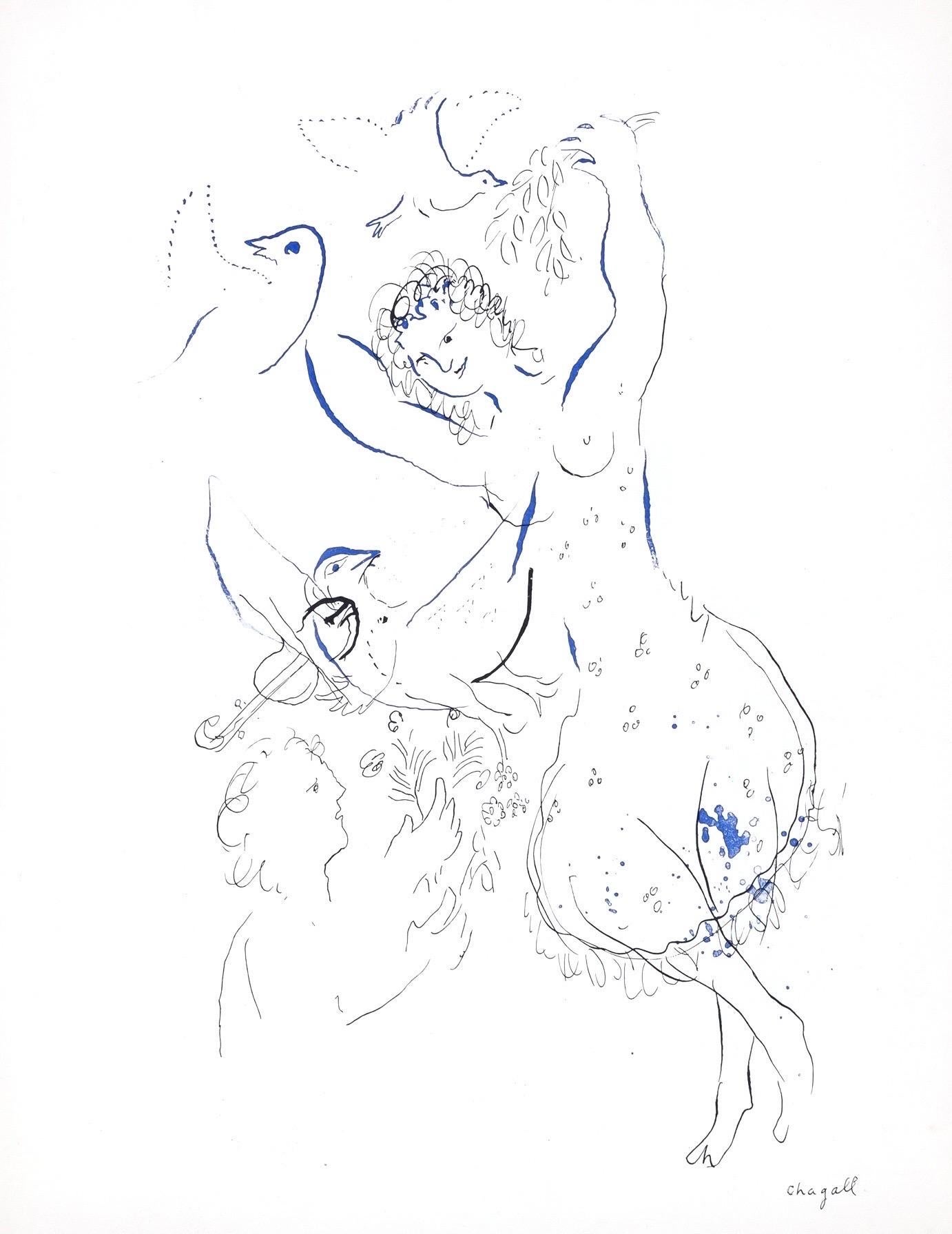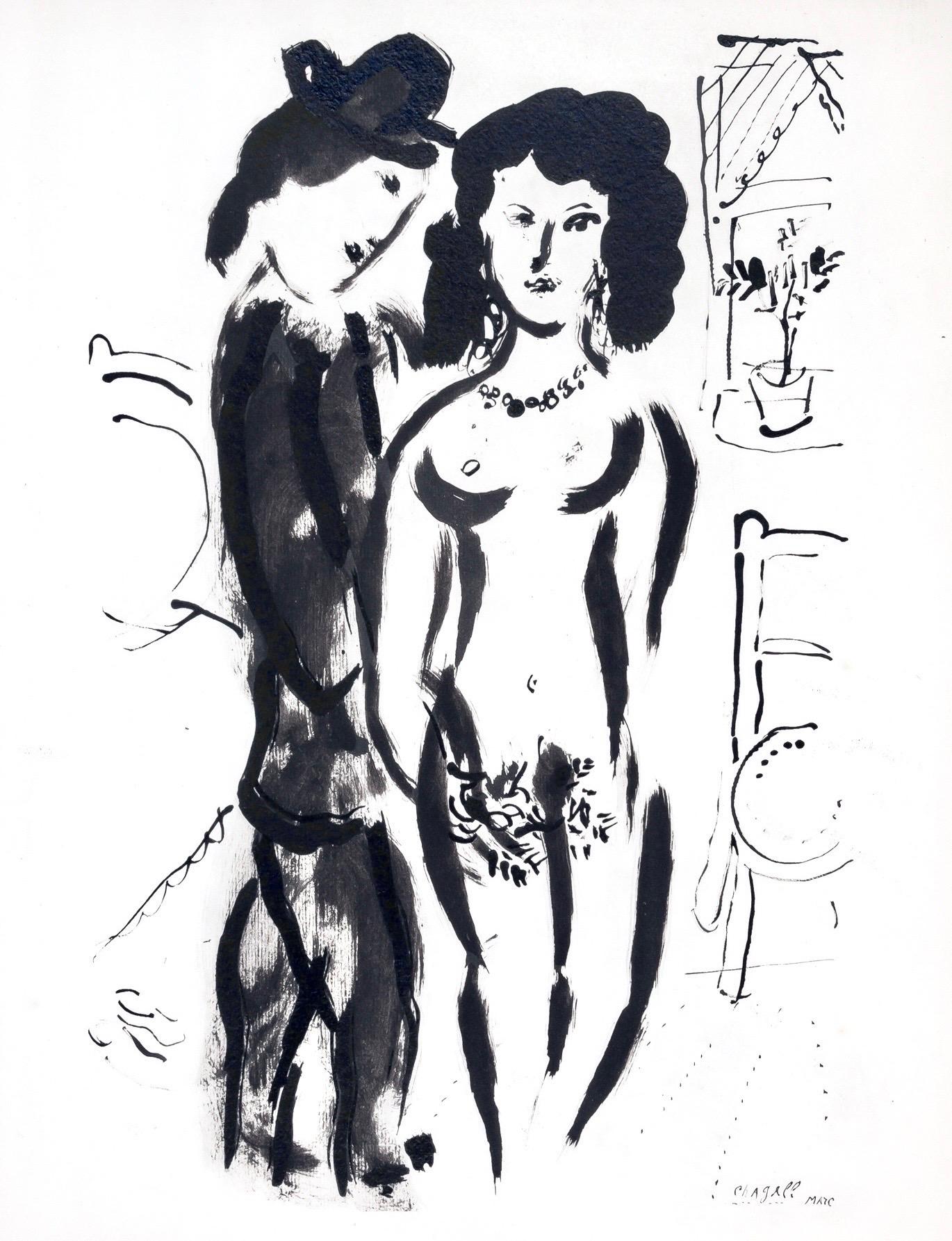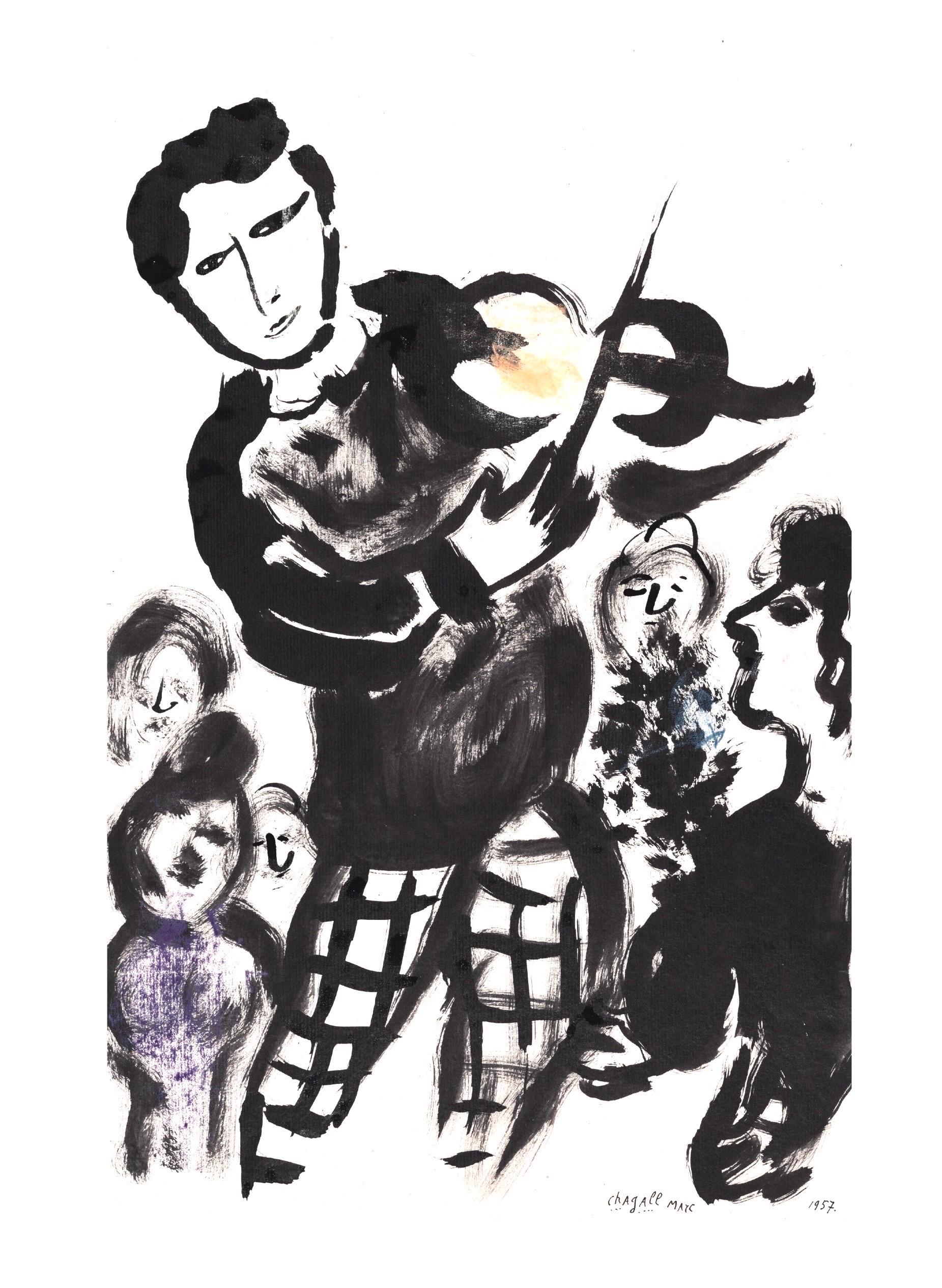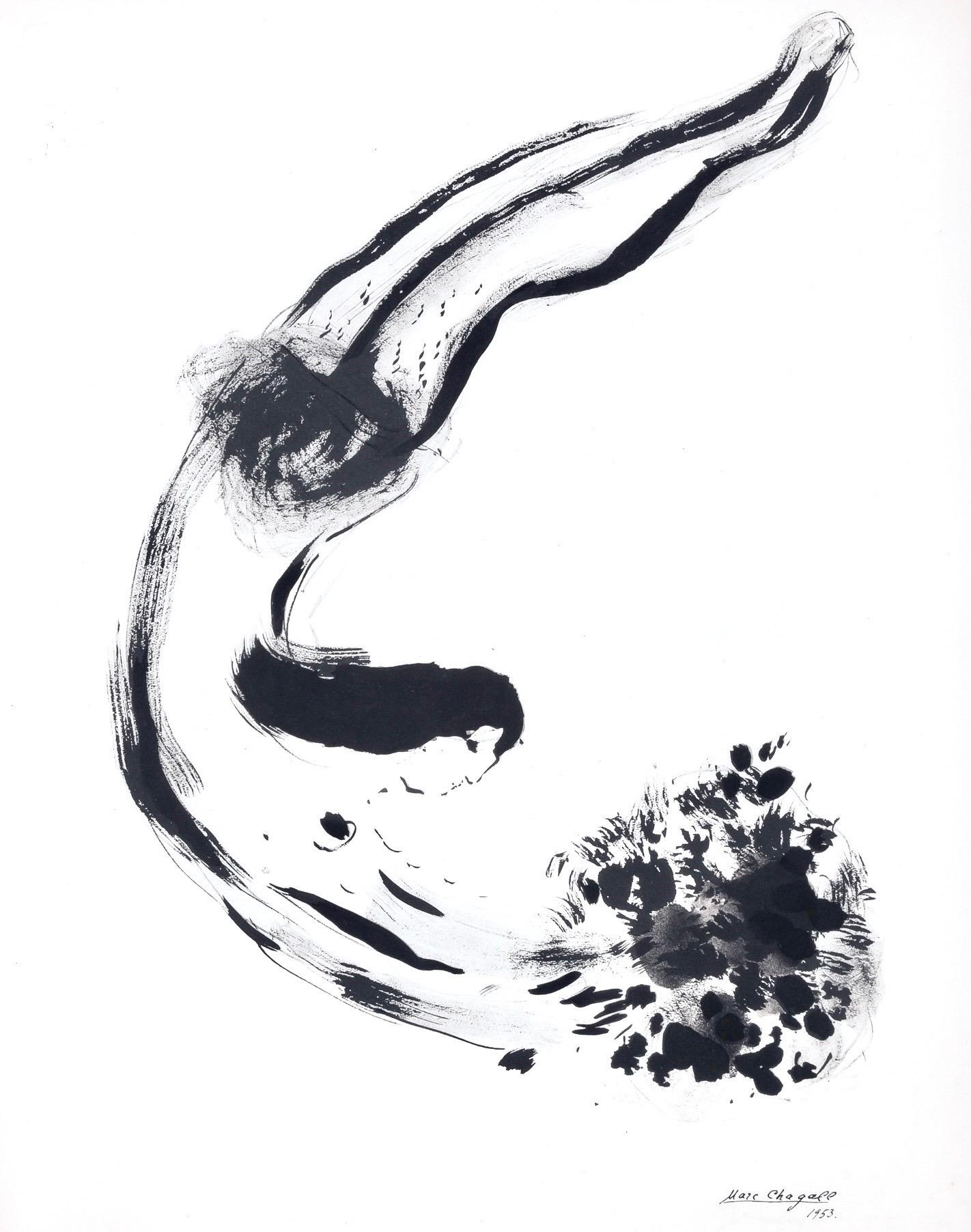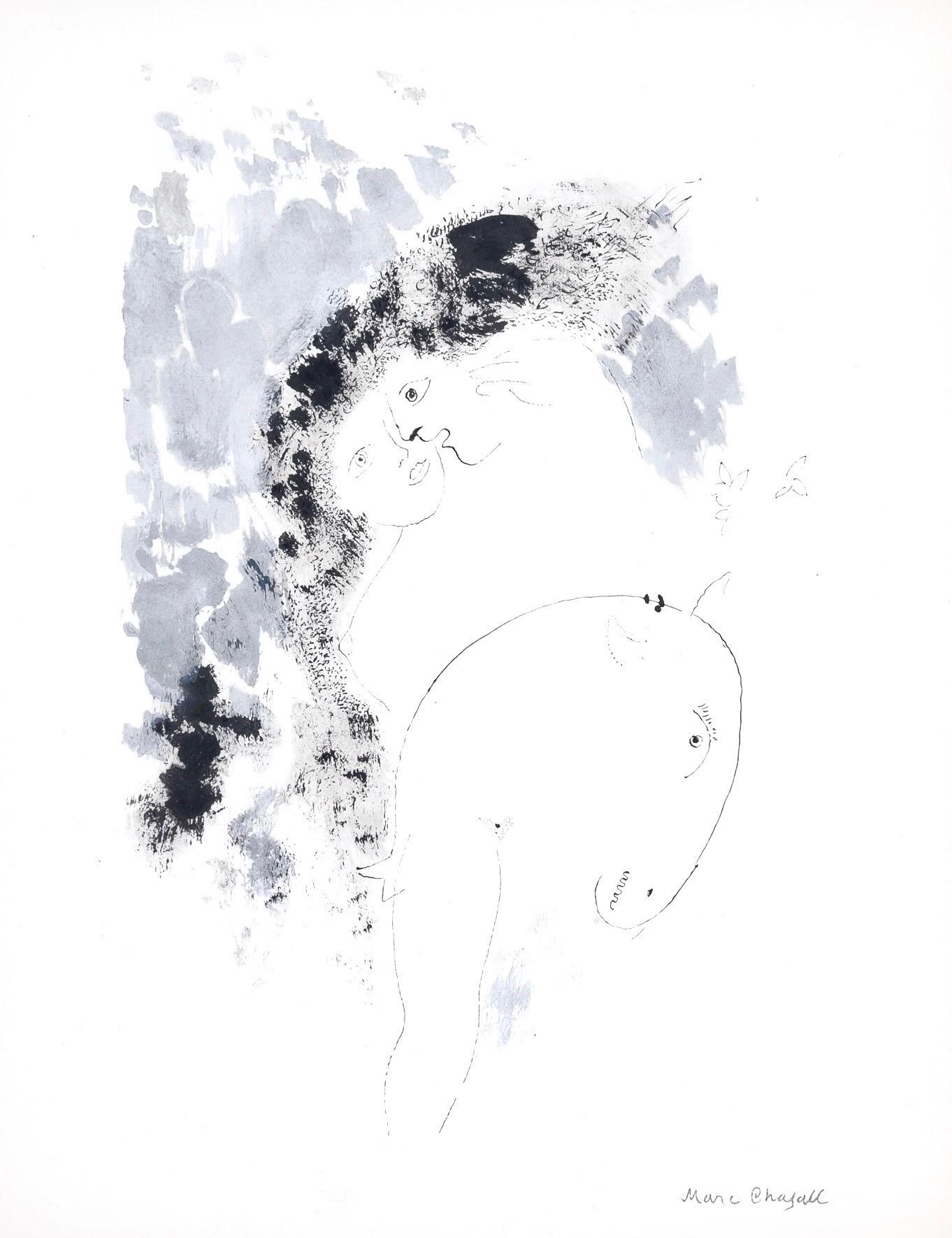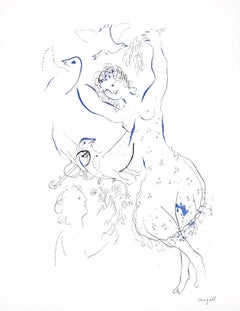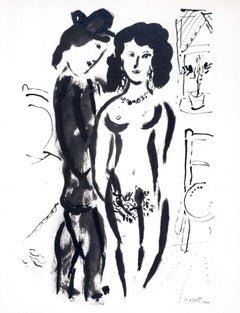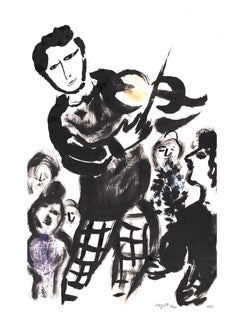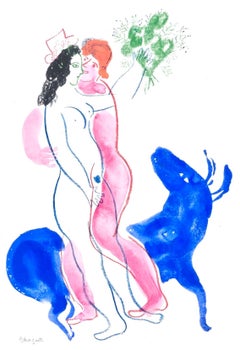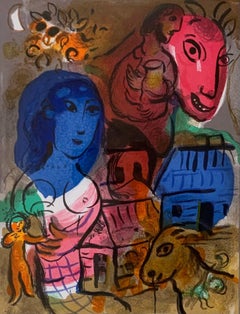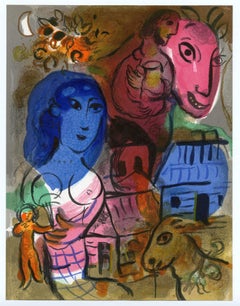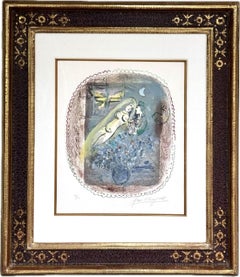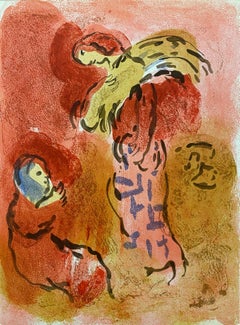Items Similar to Marc Chagall, Music, from Color of Love, 1958 (after)
Want more images or videos?
Request additional images or videos from the seller
1 of 11
Marc Chagall, Music, from Color of Love, 1958 (after)1958
1958
$7,196
$8,99520% Off
£5,593.03
£6,991.2920% Off
€6,332.84
€7,916.0520% Off
CA$10,281.71
CA$12,852.1420% Off
A$11,194.36
A$13,992.9520% Off
CHF 5,861.22
CHF 7,326.5220% Off
MX$134,369.46
MX$167,961.8220% Off
NOK 73,972.08
NOK 92,465.1020% Off
SEK 69,361.40
SEK 86,701.7520% Off
DKK 47,291.36
DKK 59,114.2020% Off
About the Item
This exquisite lithograph and pochoir after Marc Chagall (1887–1985), titled Musique (Music), from the folio Couleur amour, 13 Aquarelles, Gouaches, Lavis (Color of Love, 13 Watercolors, Gouaches, Washes), originates from the 1958 edition published by Au Vent d'Arles, Paris, and New York Graphic Society, Greenwich and Milan, and rendered and printed by Atelier Daniel Jacomet, Paris, June 15, 1958. Musique embodies Chagalls lifelong reverence for harmony, rhythm, and emotional resonance, depicting musicians enveloped in a vibrant interplay of sound and color. Through his dreamlike synthesis of form and tone, Chagall transforms music into a universal language of love and spirit, uniting the senses of sight and sound in one poetic vision.
Executed as a lithograph and pochoir on papier a la cuve du Moulin Richard de Bas specialement filigrane pour cette edition paper, this work measures 19.69 x 15.75 inches. Signed in the plate, as issued. The edition exemplifies the masterful craftsmanship of Atelier Daniel Jacomet, one of Frances foremost studios specializing in pochoir and printmaking.
Artwork Details:
Artist: After Marc Chagall (1887–1985)
Title: Musique (Music), from the folio Couleur amour, 13 Aquarelles, Gouaches, Lavis (Color of Love, 13 Watercolors, Gouaches, Washes), 1958
Medium: Lithograph and pochoir on papier a la cuve du Moulin Richard de Bas specialement filigrane pour cette edition paper
Dimensions: 19.69 x 15.75 inches (50 x 40 cm)
Inscription: Signed in the plate, as issued
Date: 1958
Publisher: Au Vent d'Arles, Paris, and New York Graphic Society, Greenwich and Milan
Printer: Atelier Daniel Jacomet, Paris
Condition: Well preserved, consistent with age and medium
Provenance: From the folio Couleur amour, 13 Aquarelles, Gouaches, Lavis (Color of Love, 13 Watercolors, Gouaches, Washes), published by Au Vent d'Arles, Paris, and New York Graphic Society, Greenwich and Milan; rendered and printed by Atelier Daniel Jacomet, Paris, June 15, 1958
Notes:
Excerpted from the album (translated from French), Couleur amour was directed by Daniel Jacomet on papier a la cuve du Moulin Richard de Bas specialement filigrane pour cette edition. The preface to this hand-composed album in Garamont Corps 24 has been completed to print on June 15, 1958 on the presses of L'Imprimerie Union in Paris. CCC numbered examples were drawn at the press of I to CCC, and XX examples outside trade marked I to XX.
About the Publication:
Couleur amour, 13 Aquarelles, Gouaches, Lavis (Color of Love, 13 Watercolors, Gouaches, Washes), published in 1958 by Au Vent d'Arles, Paris, and New York Graphic Society, Greenwich and Milan, stands among the most refined pochoir suites of mid-century modernism. Printed and directed by Daniel Jacomet at Atelier Daniel Jacomet, one of Frances foremost studios specializing in pochoir and printmaking, the portfolio exemplifies the synthesis of fine art and artisanal craft that defined the golden age of Parisian illustrated editions. Conceived as a visual poem on the theme of love, Couleur amour unites Chagalls romantic imagery with the delicate layering of gouache, watercolor, and wash techniques, rendered with exquisite fidelity through the pochoir process. The publication was printed on papier a la cuve du Moulin Richard de Bas specialement filigrane pour cette edition, a handcrafted paper produced by one of Frances oldest mills, and completed on June 15, 1958 at L'Imprimerie Union, Paris. Issued in an edition of CCC numbered examples and XX hors commerce copies, Couleur amour exemplifies the enduring collaboration between Chagall and Jacomet, whose partnership yielded some of the most celebrated artists editions and albums of the 20th century.
About the Artist:
Marc Chagall (1887–1985) was a Belarus-born French painter, printmaker, and designer whose visionary imagination, radiant color, and deeply poetic symbolism made him one of the most beloved and influential artists of the 20th century. Rooted in the imagery of his Jewish heritage and the memories of his childhood in Vitebsk, Chagalls art wove together themes of faith, love, folklore, and fantasy with a dreamlike modern sensibility. His unique style—merging elements of Cubism, Fauvism, Expressionism, and Surrealism—defied categorization, transforming ordinary scenes into lyrical meditations on memory and emotion. Influenced by Russian icon painting, medieval religious art, and the modern innovations of artists such as Pablo Picasso, Henri Matisse, and Georges Braque, Chagall developed a profoundly personal visual language filled with floating figures, vibrant animals, musicians, and lovers that symbolized the transcendent power of imagination and love. During his early years in Paris, he became an integral part of the Ecole de Paris circle, forming friendships with Amedeo Modigliani, Fernand Leger, and Sonia Delaunay, and his creative spirit resonated with that of his peers and successors—Alexander Calder, Alberto Giacometti, Salvador Dali, Joan Miro, Wassily Kandinsky, Marcel Duchamp, and Man Ray—artists who, like Chagall, sought to push the boundaries of perception, emotion, and form. Over a prolific career that spanned painting, printmaking, stained glass, ceramics, and stage design, Chagall brought an unparalleled poetic sensibility to modern art, infusing even the most abstract subjects with human warmth and spiritual depth. His works are held in the most prestigious museums around the world, including the Museum of Modern Art, the Centre Pompidou, the Tate, and the Guggenheim, where they continue to inspire generations of artists and collectors. The highest price ever paid for a Marc Chagall artwork is approximately $28.5 million USD, achieved in 2017 at Sothebys New York for Les Amoureux (1928).
Marc Chagall Musique, Couleur amour 1958, Chagall Jacomet pochoir, Chagall Moulin Richard de Bas, Chagall Au Vent d'Arles, Chagall New York Graphic Society, Chagall collectible print.
- Creation Year:1958
- Dimensions:Height: 19.69 in (50.02 cm)Width: 15.75 in (40.01 cm)
- Medium:
- Movement & Style:
- After:Marc Chagall (1887 - 1985, French)
- Period:
- Condition:
- Gallery Location:Southampton, NY
- Reference Number:1stDibs: LU1465215443562
About the Seller
4.9
Platinum Seller
Premium sellers with a 4.7+ rating and 24-hour response times
Established in 1978
1stDibs seller since 2021
1,218 sales on 1stDibs
Typical response time: <1 hour
- ShippingRetrieving quote...Shipping from: Southampton, NY
- Return Policy
More From This Seller
View AllMarc Chagall, The Dancer with Birds, from Color of Love, 1958 (after)
By Marc Chagall
Located in Southampton, NY
This exquisite lithograph and pochoir after Marc Chagall (1887–1985), titled La Danseuse Aux Oiseaux (The Dancer with Birds), from the folio Couleur amour, 13 Aquarelles, Gouaches, L...
Category
1950s Modern Figurative Prints
Materials
Lithograph, Stencil
$7,196 Sale Price
20% Off
Free Shipping
Marc Chagall, The Lovers, from Color of Love, 1958 (after)
By Marc Chagall
Located in Southampton, NY
This exquisite lithograph and pochoir after Marc Chagall (1887–1985), titled Les Amoureux (The Lovers), from the folio Couleur amour, 13 Aquarelles, Gouaches, Lavis (Color of Love, 1...
Category
1950s Modern Figurative Prints
Materials
Lithograph, Stencil
$7,196 Sale Price
20% Off
Free Shipping
Marc Chagall, The Violinist, from Color of Love, 1958 (after)
By Marc Chagall
Located in Southampton, NY
This exquisite lithograph and pochoir after Marc Chagall (1887–1985), titled Le Violoneux (The Violinist), from the folio Couleur amour, 13 Aquarelles, Gouaches, Lavis (Color of Love...
Category
1950s Modern Figurative Prints
Materials
Lithograph, Stencil
$7,196 Sale Price
20% Off
Free Shipping
Marc Chagall, The Blue Beast, from Color of Love, 1958 (after)
By Marc Chagall
Located in Southampton, NY
This exquisite lithograph and pochoir after Marc Chagall (1887–1985), titled La Bete Bleu (The Blue Beast), from the folio Couleur amour, 13 Aquarelles, Gouaches, Lavis (Color of Lov...
Category
1950s Modern Figurative Prints
Materials
Lithograph, Stencil
$7,196 Sale Price
20% Off
Free Shipping
Marc Chagall, The Offering, from Color of Love, 1958 (after)
By Marc Chagall
Located in Southampton, NY
This exquisite lithograph and pochoir after Marc Chagall (1887–1985), titled L'Offrende (The Offering), from the folio Couleur amour, 13 Aquarelles, Gouaches, Lavis (Color of Love, 1...
Category
1950s Modern Figurative Prints
Materials
Lithograph, Stencil
$7,196 Sale Price
20% Off
Free Shipping
Marc Chagall, The Dawn, from Color of Love, 1958 (after)
By Marc Chagall
Located in Southampton, NY
This exquisite lithograph and pochoir after Marc Chagall (1887–1985), titled L'Aube (The Dawn), from the folio Couleur amour, 13 Aquarelles, Gouaches, Lavis (Color of Love, 13 Waterc...
Category
1950s Modern Figurative Prints
Materials
Lithograph, Stencil
You May Also Like
Homage to Marc Chagall, from XXe Siecle
By Marc Chagall
Located in Washington, DC
Artist: Marc Chagall
Title: Homage to Marc Chagall
Portfolio: XXe Siecle
Medium: Lithograph
Year: 1969
Edition: Unnumbered
Framed Size: 20 1/2" x 17 1/4"
Sheet Size: 12" x 9 1/2"
Im...
Category
1960s Modern Figurative Prints
Materials
Lithograph
XXe Siecle-Hommage a Marc Chagall
By Marc Chagall
Located in Fairlawn, OH
XXe Siecle-Hommage a Marc Chagall
Color lithograph, 1969
Unsigned as issued by XXe Siecle
From: XXe Siecle, Volume, Special Issue Marc Chagall
Published by G. di San Lazzaro for A. M...
Category
1960s French School Figurative Prints
Materials
Lithograph
Marc Chagall "Dédicace"
By Marc Chagall
Located in Los Angeles, CA
Marc Chagall (French/Russian, 1887-1985)
"Dédicace"
1968
Color lithograph
signed and numbered ##/50 in pencil
Image: 17 7/8 x 15 1/4 inches.
Framed: 38 x 34 1/4 x 2 1/4 inches.
...
Category
Mid-19th Century Surrealist Figurative Prints
Materials
Lithograph
Ruth glaneuse
By Marc Chagall
Located in Paris, FR
Original lithograph by Marc Chagall from The Bible of 1960
Ruth glaneuse
Unsigned
35 x 26 cm
Excellent condition
Category
1960s Surrealist Abstract Prints
Materials
Lithograph
Marc Chagall - Original Lithograph
By Marc Chagall
Located in Collonge Bellerive, Geneve, CH
Marc Chagall
Original Lithograph
1963
Dimensions: 32 x 24 cm
Reference: Chagall Lithographe 1957-1962. VOLUME II.
Unsigned edition of over 5,000
Condition : Excellent
Marc Chagall (born in 1887)
Marc Chagall was born in Belarus in 1887 and developed an early interest in art. After studying painting, in 1907 he left Russia for Paris, where he lived in an artist colony on the city’s outskirts. Fusing his own personal, dreamlike imagery with hints of the fauvism and cubism popular in France at the time, Chagall created his most lasting work—including I and the Village (1911)—some of which would be featured in the Salon des Indépendants exhibitions. After returning to Vitebsk for a visit in 1914, the outbreak of WWI trapped Chagall in Russia. He returned to France in 1923 but was forced to flee the country and Nazi persecution during WWII. Finding asylum in the U.S., Chagall became involved in set and costume design before returning to France in 1948. In his later years, he experimented with new art forms and was commissioned to produce numerous large-scale works. Chagall died in St.-Paul-de-Vence in 1985.
The Village
Marc Chagall was born in a small Hassidic community on the outskirts of Vitebsk, Belarus, on July 7, 1887. His father was a fishmonger, and his mother ran a small sundries shop in the village. As a child, Chagall attended the Jewish elementary school, where he studied Hebrew and the Bible, before later attending the Russian public school. He began to learn the fundamentals of drawing during this time, but perhaps more importantly, he absorbed the world around him, storing away the imagery and themes that would feature largely in most of his later work.
At age 19 Chagall enrolled at a private, all-Jewish art school and began his formal education in painting, studying briefly with portrait artist Yehuda Pen. However, he left the school after several months, moving to St. Petersburg in 1907 to study at the Imperial Society for the Protection of Fine Arts. The following year, he enrolled at the Svanseva School, studying with set designer Léon Bakst, whose work had been featured in Sergei Diaghilev's Ballets Russes. This early experience would prove important to Chagall’s later career as well.
Despite this formal instruction, and the widespread popularity of realism in Russia at the time, Chagall was already establishing his own personal style, which featured a more dreamlike unreality and the people, places and imagery that were close to his heart. Some examples from this period are his Window Vitebsk (1908) and My Fianceé with Black Gloves (1909), which pictured Bella Rosenfeld, to whom he had recently become engaged.
The Beehive
Despite his romance with Bella, in 1911 an allowance from Russian parliament member and art patron Maxim Binaver enabled Chagall to move to Paris, France. After settling briefly in the Montparnasse neighborhood, Chagall moved further afield to an artist colony known as La Ruche (“The Beehive”), where he began to work side by side with abstract painters such as Amedeo Modigliani and Fernand Léger as well as the avant-garde poet Guillaume Apollinaire. At their urging, and under the influence of the wildly popular fauvism and cubism, Chagall lightened his palette and pushed his style ever further from reality. I and the Village (1911) and Homage to Apollinaire (1912) are among his early Parisian works, widely considered to be his most successful and representative period.
Though his work stood stylistically apart from his cubist contemporaries, from 1912 to 1914 Chagall exhibited several paintings at the annual Salon des Indépendants exhibition, where works by the likes of Juan Gris, Marcel Duchamp and Robert Delaunay were causing a stir in the Paris art world. Chagall’s popularity began to spread beyond La Ruche, and in May 1914 he traveled to Berlin to help organize his first solo exhibition, at Der Sturm Gallery. Chagall remained in the city until the highly acclaimed show opened that June. He then returned to Vitebsk, unaware of the fateful events to come.
War, Peace and Revolution
In August 1914 the outbreak of World War I precluded Chagall’s plans to return to Paris. The conflict did little to stem the flow of his creative output, however, instead merely giving him direct access to the childhood scenes so essential to his work, as seen in paintings such as Jew in Green (1914) and Over Vitebsk (1914). His paintings from this period also occasionally featured images of the war’s impact on the region, as with Wounded Soldier (1914) and Marching (1915). But despite the hardships of life during wartime, this would also prove to be a joyful period for Chagall. In July 1915 he married Bella, and she gave birth to a daughter, Ida, the following year. Their appearance in works such as Birthday (1915), Bella and Ida by the Window (1917) and several of his “Lovers” paintings give a glimpse of the island of domestic bliss that was Chagall’s amidst the chaos.
To avoid military service and stay with his new family, Chagall took a position as a clerk in the Ministry of War Economy in St. Petersburg. While there he began work on his autobiography and also immersed himself in the local art scene, befriending novelist Boris Pasternak, among others. He also exhibited his work in the city and soon gained considerable recognition. That notoriety would prove important in the aftermath of the 1917 Russian Revolution when he was appointed as the Commissar of Fine Arts in Vitebsk. In his new post, Chagall undertook various projects in the region, including the 1919 founding of the Academy of the Arts. Despite these endeavors, differences among his colleagues eventually disillusioned Chagall. In 1920 he relinquished his position and moved his family to Moscow, the post-revolution capital of Russia.
In Moscow, Chagall was soon commissioned to create sets and costumes for various productions at the Moscow State Yiddish...
Category
1960s Surrealist Figurative Prints
Materials
Lithograph
1960 After Marc Chagall 'Dans L'Atelier de Fernand Mourlot"
By Marc Chagall
Located in Brooklyn, NY
Paper Size: 17.5 x 25.5 inches ( 44.45 x 64.77 cm )
Image Size: 5.75 x 18.75 inches ( 14.605 x 47.625 cm )
Framed: No
Condition: A: Mint
Additional Details: Double page from a ...
Category
1960s Modern Prints and Multiples
Materials
Lithograph
$200 Sale Price
20% Off
More Ways To Browse
Aids Poster
Al Hirschfeld Marx
Aldo Luongo Lithograph
Alex Katz Swim
Alex Katz Swimmer
Alfred Cohen
Alice In Wonderland 1st Edition
Alphonse Mucha Vintage Poster
Antonio Bueno
Art Werger On Sale
Arte Povera Poster
Banana Split
Bauer Lithograph
Ben Shahn Signed
Bigelow Illustrations
Bob Dylan Lithograph
Bowie Haring
Bullfight Original Prints
